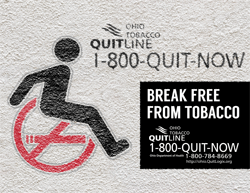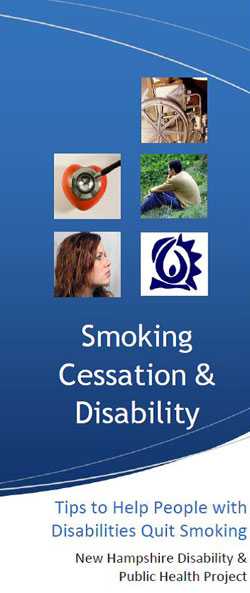Helping Everybody to Quit Smoking
 The percentage of adults who smoke cigarettes is higher among people with disabilities than people without disabilities. If more people with disabilities are included in smoking cessation programs, the percentage of those who smoke can be reduced.
The percentage of adults who smoke cigarettes is higher among people with disabilities than people without disabilities. If more people with disabilities are included in smoking cessation programs, the percentage of those who smoke can be reduced.
Tobacco use continues to be the leading preventable cause of death in the United States.1 Although progress has been made with reducing cigarette smoking among U.S. adults, declining from 1 in 5 adults in 2005 (45.1 million smokers) to 1 in 6 adults in 2015 (36.5 million),2 differences in prevalence of smoking between groups of people still persist. For example, in 2014, cigarette smoking was significantly higher among those who reported having any disability (more than 1 in 5 were smokers) compared to those who reported having no disability (about 1 in 6 were smokers). In addition, similar to people without disabilities, research shows that the percentage of smokers among people with disabilities also differs by race and ethnicity. For instance, the percentage of American Indian/Alaska Natives with a disability who smoke cigarettes was almost three times as high as among Asians with a disability (41.2% versus 12.8%).3
These differences in rates of smoking underscore the importance of making sure that programs that focus on reducing smoking to promote health and prevent long-standing diseases—like diabetes and heart disease—are inclusive , not only for people from diverse racial and ethnic groups, but also for people with disabilities. Inclusive smoking cessation programs need to be accessible to those who want to participate and in some cases adapted to address the needs and expectations of the target population, for example, educational campaigns can include images of people with disabilities and information on how to request accommodations in promotional materials.
Inclusive Public Health Programs and Campaigns
Access to proven smoking cessation treatments and services, along with targeted media campaigns that not only warn about the dangers of tobacco use, but also effectively address the challenges people with disabilities may face when accessing these resources, can save lives, including those of people with disabilities. There is clear evidence showing that comprehensive tobacco control programs can reduce smoking rates, tobacco-related deaths, and diseases caused by smoking.
To reduce and prevent smoking among people with disabilities, public health programs can:
- Include measures of disability in public health surveys and research activities to monitor smoking prevalence among adults with disabilities;
- Identify health differences between people with and without disabilities from diverse racial and ethnic groups;
- Understand the challenges people with disabilities from diverse racial and ethnic groups face in participating in programs and activities that promote health and prevent long-standing diseases like heart disease and diabetes;
- Update existing health promotion campaigns or programs with targeted smoking cessation messages for people with disabilities; and
- Develop and implement strategies for promoting health and preventing disease that are inclusive, recognize diversity of the smoking population, and are accessible for people with disabilities.

The Ohio Disability and Health Program and the Ohio Department of Health’s Tobacco Program teamed up to create smoking cessation materials that target people with disabilities.

The Michigan Tobacco Quitline is unique in its barrier-free approach to cessation assistance.

New Hampshire provides tips to help people with disabilities quit smoking.
What is CDC Doing to Reduce Smoking among People with Disabilities?
CDC provides funding to 19 State Disability and Health Programs that work to improve the health and wellness of people with disabilities by including them in health promotion activities to reduce smoking. For example,
The Ohio Disability and Health Program collaborated with the Ohio Department of Health’s Tobacco Use Prevention and Cessation Program (TUPCP) to encourage people with disabilities to use the Ohio Tobacco Quit Line.
- The highlights of the program include:
- Collaborating with TUPCP to add a disability screener question to the Quitline intake form to track people with disabilities who use the service. The addition of this identifier allows the program to track change in use of the Quitline by people with disabilities over time.
- Collaborating with TUPCP to create a mass media campaign to raise awareness of the Quitline among people with disabilities. Focus groups were held to gather feedback from the disability community in the development of effective marketing materials. During the 3-month campaign, the proportion of callers with a disability who called the Quitline, relative to all callers, increased by 25%.
- Engaging in a Tobacco Cessation Community of Practice that included TUPCP and National Jewish Health (provider of Ohio Tobacco Quitline). This work resulted in National Jewish Health requiring disability sensitivity training for Tobacco Quitline counselors.
Members of the Disability and Health and Tobacco units at the Michigan Department of Health and Human Services (MDHHS) are working together to promote the Michigan Tobacco Quitline among people with disabilities.
- The highlights of the program include:
- Training vocational service specialists—those who work directly with employees—at Peckham Industries. Peckham is the largest vocational rehabilitation agency in Lansing (Michigan’s capitol), and the agency employs quite a few people with disabilities. Among other employee services, Peckham assists employees who wish to quit tobacco. Since the training, Peckham has changed its policies so that all employees who wish to quit tobacco are automatically referred to the Michigan Tobacco Quitline.
- Partnering with a creative advertising class at Michigan State University, students were asked to design posters and other print materials that creatively illustrate the differences in smoking rates for various groups of people and the importance of accessible smoking cessation resources. This raised awareness about access and inclusion among the students and provided strong visual messages that MDHHS is using to promote the Michigan Tobacco Quitline among people with disabilities.
The New Hampshire Disability and Public Health Program developed materials that can be used by healthcare providers to support people with disabilities who want to quit smoking.
- The highlights of the program include:
- Developing a smoking cessation brochure [] that offers tips to help people with disabilities quit smoking.
- Exploring the possibility of including disability identifiers on the state’s Quitline intake form.
- Providing technical assistance and offering training to the New Hampshire Tobacco Prevention and Cessation Program (TPCP) to improve inclusion and accessibility of the program.
References
- U.S. Department of Health and Human Services. The Health Consequences of Smoking—50 Years of Progress. A Report of the Surgeon General. Atlanta: U.S. Department of Health and Human Services, Centers for Disease Control and Prevention, National Center for Chronic Disease Prevention and Health Promotion, Office on Smoking and Health, 2014.
- Jamal A, King BA, Neff LJ, Whitmill J, Babb SD, Graffunder CM, . (2016) Current Cigarette Smoking Among Adults — United States, 2005–2015. CDC. MMWR Morb Mortal Wkly Rep. 65(44); 1205-1211.
- Courtney-Long EA, Romano SD, Carroll DD, Fox MH. (2016) Socioeconomic Factors at the Intersection of Race and Ethnicity Influencing Health Risks for People with Disabilities. J Racial Ethn Health Disparities. Advance online publication.
Glossary
Prevalence is the ratio or percentage of people with a characteristic or condition. The prevalence of smoking among members in a racial or ethnic group is the number of people in the group who smoke out of everyone in the group. Prevalence can be shown as a ratio (like 1 in 5) or as a percentage (like 20.6%).
Smoking cessation programs, also known as tobacco control programs, are programs that help people quit smoking. There are a variety of programs to help people quit smoking, including counseling and medications.
More Information
More Information
Quit Smoking
- CDC’s Office on Smoking and Health also conducts the Tips from Former Smokers campaign which features people with disabilities or conditions caused by smoking. The campaign also directs such smokers to resources which can help them quit.
- Quit Smoking Resources
Resources
- Page last reviewed: November 22, 2016
- Page last updated: November 22, 2016
- Content source:
- National Center on Birth Defects and Developmental Disabilities
- Page maintained by: Office of the Associate Director for Communication, Digital Media Branch, Division of Public Affairs




 ShareCompartir
ShareCompartir
